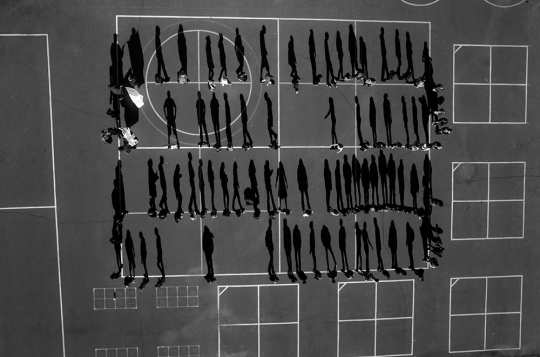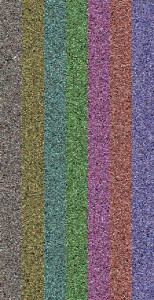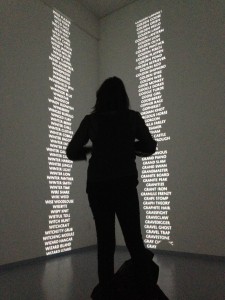Art in a Time of Surveillance
ARTS, 18 Nov 2014
This just happened — while trying to figure out a colorful way to begin the story you’re reading, I toggled to Twitter and saw a link to a short film by two Brooklyn directors who used a drone to film actors having sex. Their project, somewhere between art and porn, hovers on the R-rated margins of a thriving cultural movement in which artists of all stripes are exploring what it means to live in a state of surveillance.
You can’t throw a rock these days without hitting a surveillance art project, and the remarkable thing is that so much of it is so good. Some of the Snowden era’s sharpest interrogations of collect-it-all tracking by corporations and the government are to be found in galleries and other art spaces. They are the opposite of the acronym-laden news stories we read: NSA, FISA, PGP, PRISM, ACLU, EFF, SIGINT, GCHQ, TOR, FOIA, HTTPS, are you still awake? They are playful, invasive and eerie, and best of all they are graphically visual. With a transgressive edge that journalism struggles to match, they creatively challenge what it means to be human in a time of data.
The latest example is an exhibit called Watching You, Watching Me, organized by the Open Society Foundations in New York City and featuring ten artists and photographers. Rather than tell us about program X or problem Y in the word-based vernacular we’re numbed by, they offer new ways of seeing and understanding surveillance. The stunner in this show is an object created by Hasan Elahi that from a distance looks like a lovely tapestry draped on a wall.
As Elahi has explained, in 2002 he was stopped at the Detroit airport because his name appeared on a terrorism watchlist, and he was subsequently interrogated by FBI agents. Born in Bangladesh and raised in the United States, Elahi, an art professor at the University of Maryland, chose an unusual response to clear his name and make a statement—he began a self-surveillance project in which he took pictures of nearly everything he did and sent them to the FBI. He also posted them to a website he created. He’s taken about 70,000 pictures of the buildings he’s visited, the beds he’s slept in, the food he’s eaten, the toilets he’s used, the roads he’s travelled on, and he’s also published receipts for the things he’s bought; he even tracks his location using GPS.
“By disclosing mundane details about my daily life, I am simultaneously telling everything and nothing about my life,” he writes in the exhibit brochure. “I am flooding the market with banal information, and questioning its inherent meaning and value for intelligence purposes.”
For the exhibit, Elahi created a giant tapestry made of tiny reproductions of 32,000 of those photos. It works on several levels. Aesthetically and from afar, it is a gorgeous, softly-colored flag, something Jasper Johns might have created with fabric. Up close, you see each photo and comprehend the audacity of Elahi’s monitoring project as well as the invasive banality of surveillance (though the photos were shot by Elahi, they are the sorts of things spy agencies might collect on their targets). You can also read the photos as a visual story of a man’s life in America, or more broadly as life in America, with its fast-food restaurants, its parking lots and planes and strip malls. His artwork is the analog turned digital turned material.
Surveillance art — or as one academic has called it, artveillance — fits into a creative continuum that stretches back to at least the 1930s, when the introduction of “miniature” cameras, such as the Leica, made it relatively easy for photographers to secretly take pictures. Walker Evans led the way with undercover pictures taken on the New York City subway with a Leica hidden behind his coat. State surveillance wasn’t the subtext of Evans’ work—he was the surveiller, after all—but as the art professor Stephanie Schwartz pointed out to me, the issue was being evoked in the creative realm at the time. One of the scenes in Modern Times shows Charlie Chaplin’s character, the tramp, going into a bathroom to get away from the factory floor, only to find a monitor from which the factory manager sees him and orders him back to work.
The latest wave of surveillance art has been evident for a number of years, especially since 9/11, which increased the powers and budgets of intelligence agencies in the United States and elsewhere. The wave seems to have grown larger in the wake of the leaks from NSA whistleblower Edward Snowden, and this is fortunate. Pervasive surveillance is oddly paralyzing—it is the digital equivalent of the aphorism about genocide, “The death of one man is a tragedy and the death of a million is a statistic.” The more we learn of its vast scope, the more we seem dulled to it. We need to see it anew.
Josh Begley, a data editor at The Intercept, tries to bring that kind of utility to the New York Police Department’s invasive surveillance of Muslims. After 9/11, the NYPD established a secret “Demographics Unit” that mapped Muslim neighborhoods, dispatching plainclothes officers to collect photographs and information about Muslim businesses and gathering places. The program was revealed in a 2011 news story by the Associated Press that also published the NYPD’s surveillance photos and notes.
Begley’s project in the Watching You exhibit reassembles the original documents, arranging the NYPD photos of hundreds of Muslim-owned establishments in a jaggedly circular collage, surrounded by notes from the undercover cops involved in the surveillance (“Medium sized store that sells stationary, lotto, newspapers and American party supplies…Location sells live poultry…A male Pakistani was working behind the counter”). The project engages you far more deeply than a stack of original documents or news stories about them ever could.
The exhibit offers much more—photojournalist Tomas van Houtryve displays his beautiful and disturbing pictures taken with a small drone that he flew over American settings to replicate the locations of drone strikes in Pakistan and Afghanistan—weddings, playgrounds, people praying or exercising. There is also the turn-the-tables work of Simon Menner, a German who combed through the Stasi archives for pictures the East German spy agency took of its own agents (mainly in training situations, but also at parties).
It’s just a microcosm of today’s vibrant surveillance art scene. Travel a few dozen blocks from the Open Society and you’ll reach the latest work by Trevor Paglen, who has collected more than 4,000 code names from the archive of NSA documents leaked by Snowden. Paglen’s video installation, in a darkened room at the Metro Pictures gallery, projects the code names into slowly-rising columns of white type that crawl up the walls around you. The effect is literally destabilizing—with the code names rising as you stand still, you feel as though you are falling in a shaft of infinite surveillance. Paglen materializes our political vertigo.
As a writer, it’s hard to say this but there’s more variety and excitement in surveillance art than in surveillance writing. For instance, artist Heather Dewey-Hagborg has collected DNA samples from cigarette butts, chewing gum and stray hair, and has used these to create portraits of whomever the DNA belongs to. It’s an aggressive act — appropriating someone’s genetic property to show the ease with which our identities can be constructed and exposed. Two artists, Brian House and Kyle McDonald, even created an eavesdropping device that looks like a light bulb or lamp, and after infiltrating them into public places like a restaurant, bank lobby and library, they tweeted snippets of overheard conversations; the project is called “Conversnitch.”
Fair game? I don’t know, but these projects engage us with the problems of surveillance in ways that news stories and congressional hearings do not. There’s a freshness to each one, and the list lengthens every day. As I was finishing this story, I received an email from a group of 14 artists who have released a CD called “NSA Listening Party” — songs against surveillance. The first track is called “Dossier.”
Here are some other surveillance projects and artists we’ve noticed:
Privacy Policy: The Anthology of Surveillance Poetics
Jenny Holzer (Doodle)
PRISM: The Beacon Frame (Julian Oliver and Danja Vasiliev)
Lauren McCarthy (Social Turkers)
James Bridle (Drone Shadows)
Adam Harvey (Privacy Gift Shop)
Omer Fast (5,000 Feet is the Best)
David Birkin (The Shadow of a Doubt)
Essam (NYPD Drone Art)
ScareMail (Ben Grosser)
America/Pardon Snowden (Larry Ayres and Miriam Dance)
Treason (Galt Aureus)
SkyWatch Spider (Zaq Landsberg)
ZXX Type (Sang Mun)
Banksy (GCHQ mural)
Post-Surveillance Art (Suzanne Treister)
PolyCopRiotNode (CH2)
The Personal Experience of Surveillance
__________________________________
Photo: Tomas van Houtryve
Email the author: peter.maass@theintercept.com
Go to Original – firstlook.org
DISCLAIMER: The statements, views and opinions expressed in pieces republished here are solely those of the authors and do not necessarily represent those of TMS. In accordance with title 17 U.S.C. section 107, this material is distributed without profit to those who have expressed a prior interest in receiving the included information for research and educational purposes. TMS has no affiliation whatsoever with the originator of this article nor is TMS endorsed or sponsored by the originator. “GO TO ORIGINAL” links are provided as a convenience to our readers and allow for verification of authenticity. However, as originating pages are often updated by their originating host sites, the versions posted may not match the versions our readers view when clicking the “GO TO ORIGINAL” links. This site contains copyrighted material the use of which has not always been specifically authorized by the copyright owner. We are making such material available in our efforts to advance understanding of environmental, political, human rights, economic, democracy, scientific, and social justice issues, etc. We believe this constitutes a ‘fair use’ of any such copyrighted material as provided for in section 107 of the US Copyright Law. In accordance with Title 17 U.S.C. Section 107, the material on this site is distributed without profit to those who have expressed a prior interest in receiving the included information for research and educational purposes. For more information go to: http://www.law.cornell.edu/uscode/17/107.shtml. If you wish to use copyrighted material from this site for purposes of your own that go beyond ‘fair use’, you must obtain permission from the copyright owner.


